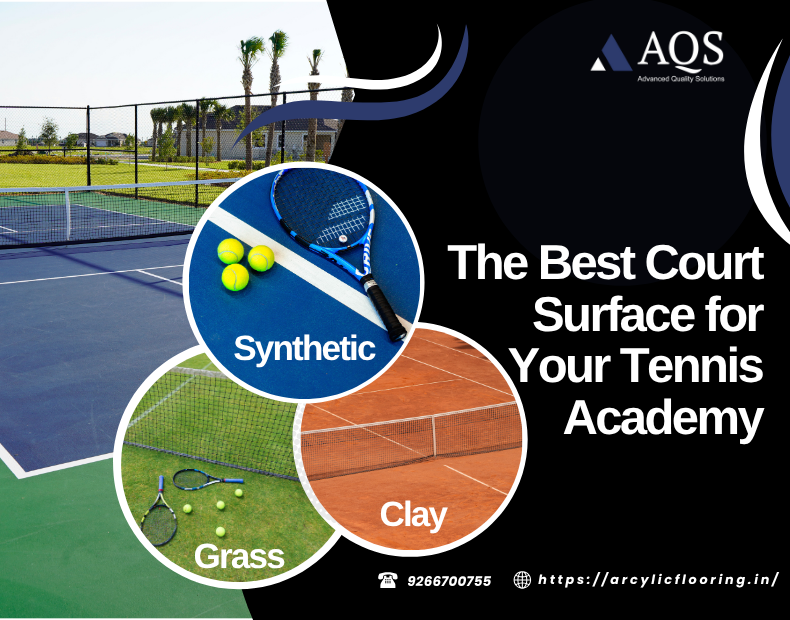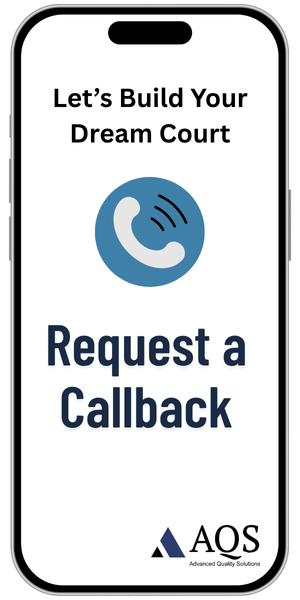
The success of your tennis court academy depends on the types of tennis court flooring. Choosing the right tennis court surface when setting up a tennis facility has a major effect on player growth, upkeep expenses, and how flexible the courts are. Hard courts remain the go-to option around the globe. They are popular in schools, community clubs, and public recreational areas.
At AQS, we see that tennis courts come in many types with different ways they affect gameplay. International Tennis uses speed levels to rank surfaces, starting from level one, which is slow, to level five, which is fast. Hard courts are medium-fast and deliver a steady bounce, while clay courts make the game slower and cause the ball to bounce higher. This favors athletes who have great stamina. Synthetic grass courts are useful in another way—they allow other sports like hockey, cricket, netball, and basketball to be played on them too.
Choosing the best surface matters for more than just tennis. A reliable and low-maintenance surface that performs well all year can boost your property’s worth and significantly contribute to the success of your academy. This guide will dive into the best tennis court surfaces to help academies compare classic and modern options so you can pick the most suitable one.
Learning About Tennis Court Surface Types
Understanding the differences between tennis court surface types is crucial when investing in courts for any tennis academy. Each type influences playing styles, Training outcomes, and future expenses. Tennis court design helps improve player safety and keeps the surface in good condition for years.
Hard Courts: A Surface for All Skills
Courts are made by layering synthetic acrylic over asphalt or concrete bases. These courts serve as a balanced surface with reliable ball bounce and fast speed, helping players improve all-around skills. Maintaining hard courts is straightforward; cleaning keeps them usable for a long time. The US Open and Australian Open are played on hard courts, proving their importance at the professional level. However, the unforgiving surface can lead to extra stress on players’ joints after long practice.
Clay Courts: To Play from the Baseline
Clay courts built using crushed brick, stone, or shale provide special benefits to academies aiming to improve players’ technical skills. Among all court surfaces. It allows balls to bounce higher and lengthens rallies, pushing players to focus on tactics instead of just power. Research confirms clay courts have a role in lowering knee and back injuries because the friction between shoes and the surface is reduced. Traditional red clay courts need tons of crushed bricks per court and demand daily care, such as watering and sweeping. Synthetic clay offers a good alternative for academies in India, giving the same feel with less effort to maintain.
Grass Courts: Quick Play but Tough to Maintain
Grass courts, the original tennis surface, offer the quickest gameplay due to their low bounce. They favor players who at strong serves and swift net actions, fine-tuning distinct abilities. While this surface looks good, keeping it in good shape takes a lot of effort. Grass courts require frequent mowing every two or three days, along with watering and rolling. Maintaining them throughout the year is also essential to provide ideal conditions during the playing season. Because of these demands, most academies avoid installing grass courts unless they can handle the upkeep.
Synthetic Courts: A Modern Option for Tennis Academies
Modern synthetic surfaces have brought big changes to tennis academies by offering great adaptability and performance. These courts handle all kinds of weather, including hot summers and heavy rains, making them useful in India’s climate. Synthetic acrylic surfaces offer steady ball bounce and need very little upkeep compared to other options. Many of these surfaces come with ITF certification, which ensures their grip, speed, and ball bounce meet international rules. Academies can also create unique court designs and choose custom colors that strengthen their brand identity. To follow ITF rules, courts must be planned, and details like layout and markings are important for safety and good play.
Key Points When Picking the Best Surface to Build a Tennis Academy
Choosing the right tennis court surface requires juggling a mix of factors that affect how players grow, what it costs to maintain, and how long your facility lasts. Knowing these important details helps make sure your investment fits your academy’s goals.
Training Goals and Player Type
The players you cater to drive how you pick the surface. Competitive athletes look for fast and responsive courts that resemble tournament setups, helping them build real-world match skills. On the other hand, recreational players like surfaces that feel softer or slower, putting comfort first. How the surface plays is important as well—quicker courts push players toward net volleys, while slower ones foster baseline rallies, which improves strategy. Start by figuring out if your focus lies in training future pros or engaging the local community.
Climate and Weather Considerations
Climate plays a big role in how well tennis courts perform and how long they last. Extreme temperatures make surfaces expand and shrink, which can lead to cracks if the materials used are not flexible enough. Strong sunlight fades colors faster and wears down the surface. High humidity slows down the drying time of acrylic paints during setup. In places with a lot of rain, good drainage is needed to prevent water damage like erosion or blisters on the surface. Acrylic tennis court surfaces are now the go-to choice for outdoor courts because they handle tough weather well.
Upkeep Needs and Prices
Over time, keeping up courts costs more than setting them up in the first place. Clay courts need a lot of care, like watering, rolling, and brushing. To maintain natural grass, people use special tools to water, mow, and add fertilizer. Hard courts and synthetic ones need much less work. Cleaning and resurfacing once in a while is enough. Fixing up the surface cost depending on its condition. Most hard courts need resurfacing every 4 to 8 years, depending on how often they are used.
Durability and Usability All Year
Playing all year lets players train and makes the investment worth it. Hard and synthetic acrylic courts last longer when dealing with different weather conditions. Good drainage systems stop water from pooling, which can harm court surfaces. Choosing acrylic options with UV protection helps slow damage. To make courts last longer, people reapply acrylic coatings every five to seven years.
ITF Tennis Court Surface Guidelines
The International Tennis Federation splits court surfaces into five groups based on how fast the ball moves:
- Category 1: Slow
- Category 2: Medium-Slow
- Category 3: Medium
- Category 4: Medium-Fast
- Category 5: Fast
ITF certification makes sure tennis court surfaces follow strict rules for ball bounce, safety, and consistent play. This approval matters a lot if your academy wants to hold competitive events. AQS suggests picking surfaces that fit your training style while staying within these rules.
Synthetic or Clay: What’s Best for a Tennis Academy?

When choosing courts for a tennis academy, synthetic and clay surfaces are the most common options. AQS has looked into both to figure out which works better for players learning and growing their skills.
Performance: Bounce, Speed, and Spin
Clay courts and synthetic courts feel very different during play. On clay courts, the ball slows down a lot because of the high friction when it hits the surface. This makes the ball lose speed and momentum, leading to longer rallies and extended points. Such conditions are great for improving tactical gameplay. In contrast, synthetic surfaces keep the bounce and speed of the ball consistent, which helps players train in a more predictable way. Balls also tend to bounce higher on clay, although this depends on the weather. For instance, on hot sunny days, the bounces can get even higher.
Preventing Injuries and Reducing Strain on Joints
Studies repeatedly demonstrate that clay courts have better joint protection. Reports highlight that fewer injuries happen on clay courts than on hard surfaces. This difference comes from the lower friction that clay offers. Research even found high-friction courts cause painful injuries five to eight times more often than surfaces that allow sliding. Sliding on clay helps cut down joint impact. Even so, some modern synthetic surfaces now include features that absorb shock to safeguard muscles and joints.
Training Flexibility and All-Sport Adaptability
Synthetic tennis courts stand out because of their flexibility. These surfaces are great not just for tennis but also to play other sports like hockey, cricket, basketball, and netball. This ability to support various sports increases how much a facility gets used and how much money it can bring in. Additionally, synthetic courts perform well no matter the weather, making them available to train on throughout the year. While clay courts are fantastic for focusing on improving tennis skills, they cannot be used for a range of different sports.
Maintenance Contrast
The upkeep needed for these surfaces varies a lot. Natural clay courts need work every single day. This includes watering, sweeping, leveling, and rebuilding a large part of it once spring starts. On the other hand, synthetic courts are much easier to handle. Cleaning them every so often and doing basic checkups are enough. Some artificial clay options like “ClayTurf” offer the feel of real clay but with far less care involved.
Cost of Tennis Court Flooring in India
In India, building a clay tennis court costs less, while synthetic courts cost more than a clay court. Over time, though, synthetic courts cost less to maintain, making them a better long-term option. Acrylic tennis court floors cost depends on the quality and number of layers used. When planning the full expenses, it is important to think about both the setup cost and how much it takes to upkeep the court. Even though synthetic courts cost more at first, they save money.
Installation and Materials: Making a Tennis Court That Lasts
How your tennis court performs and holds up over time depends a lot on the way it is built. To build a court that stays in good shape, you need to choose the right materials and use careful construction methods.
Common Tennis Court Flooring Types in India
Tennis courts in India often use materials like synthetic acrylic surfaces, PU systems, PP tiles, and artificial turf. Synthetic acrylic is chosen because it holds up well against weather changes and requires little upkeep. It handles India’s tough climate—scorching summers and heavy rains—without getting damaged or losing color. ITF-certified acrylic systems with 5 or 8-layer designs work best for outdoor courts, delivering reliable performance.
Comparing Concrete Base with Acrylic Tennis Surfaces
Acrylic tennis courts need a base made from either concrete or asphalt. This base gives stability and helps the synthetic surface stick. Builders reinforce concrete bases first to prevent cracks. After that, they add several layers of acrylic to form the actual playing surface.
Steps to Build a Tennis Court
Creating a professional tennis court includes important stages. Here is a general guide on how to get started:
- Start with clear goals in mind.
- Prepare and level the site.
- Lay a strong foundation using aggregate materials.
- Build the base with asphalt or concrete
- Apply several layers of acrylic and let them dry
- Add the accessories and complete the layout and markings
Drainage and UV Protection
Good drainage stops water from collecting on the court, which could damage the surface and disrupt play. Outdoor courts need a slope of around 1% to guide water away. In addition, systems like concrete spoondrains and underground slotted drains help move water off the court. Protecting against UV rays is just as important since sunlight can wear down surfaces and fade colors. High-quality tennis court floors feature coatings that resist UV rays and keep the surface durable even under constant sunlight.
How to Pick a Tennis Court Flooring Company in India
To pick the right tennis court flooring company in India, focus on ones that provide ITF-certified products. These meet the standards needed for proper ball bounce, grip, and overall play. Look at manufacturers who hold ISO certifications like ISO 9001:2015 to maintain quality or ISO 14001:2015 to meet environmental rules. At AQS, we suggest checking a company’s experience and their ability to give technical support and after-service help. The best companies offer complete solutions. They should guide you on design decisions, materials to use, how to install, and how to maintain the court well.
Conclusion
Picking the best surface for a tennis court is one of the most important steps to take when setting up a tennis academy. In this guide, AQS has looked at how different types of tennis court floors affect how players improve, how much upkeep they need, and how they add to the overall worth of the facility.
Good tennis court flooring lays the groundwork to train top players while giving you a better return on your investment. If you choose, your court surface isn’t just a place to play—it becomes a tool to train and boost your academy’s quality and reputation. Great players aren’t just coached into champions—they also train on courts that get them ready to succeed at all levels.
Frequently Asked Questions
The ideal surface for a tennis academy depends on various factors, but synthetic and hard courts are often preferred. They offer a good balance of performance, durability, and low maintenance, making them suitable for year-round training in diverse weather conditions.
Different surfaces impact player development in unique ways. Hard courts provide consistent bounce and speed, ideal for all-round skill development. Clay courts slow the game down, promoting strategic play and endurance. Grass courts encourage quick reflexes and net play, while synthetic surfaces offer versatility and consistent performance.
Key factors include player level and training goals, local climate conditions, maintenance requirements and costs, durability, year-round usability, and compliance with ITF standards. It’s also important to consider the long-term economics, including both initial installation and ongoing maintenance expenses.
Climate plays a crucial role in surface selection. Synthetic and hard courts generally withstand diverse weather conditions best. For areas with extreme temperatures or heavy rainfall, proper drainage and UV-resistant materials are essential. Some surfaces, like clay, may require additional maintenance in certain climates.




